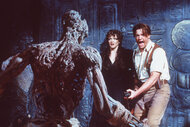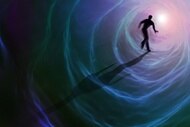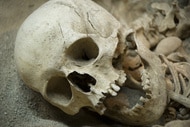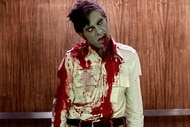Create a free profile to get unlimited access to exclusive videos, sweepstakes, and more!
The seduction of death (or, OK but what if the Grim Reaper is, like, hot?)

Death comes for us all. It is the only inevitability of life, a certainty that we can never escape and a fear that haunts each and every one of us. It also, of course, ceaselessly fascinates us. How could it not? Centuries of art have been defined by this specter, and modern-day geek culture is no different. Entire civilizations were born from this obsession, as well as endless trends, fads, and fetishes, including Victorian séance tea parties, goth subcultures, dark erotica, and much more.
Humans are predictable creatures. We react in very familiar ways when we are confronted by our fears. We run away, we deny the inevitable, we try to find ways to escape it or come to terms with what will eventually come. And then we figure out ways to f*** it. Unsurprisingly, death is no different.
We have talked frequently on this beautiful website about the sexy appeal of the taboo — mermaids, robots, vampires, and everything in between. What ties all of these creatures together is the idea of confronting the illicit through metaphor and using pop culture as a safe space to explore issues that society has made unmentionable. Vampires represent our relationship with death, mermaids are often an allegory for queer issues, robots embody our fetishizing of technology, and so on. It's less about the monsters themselves than it is what they represent (although, of course, it does help when pop culture is overloaded with hot depictions of them all). So, when we have all of these metaphorical explorations of death and its allure, what happens when the sexy part is literally death itself?
A popular motif in art that exemplifies this is the image of Death and the Maiden, which typically takes shape in the form of two figures, a young beautiful woman and the personification of Death himself. The pair are frequently painted in loving embraces or more forceful positions, but the subtext is almost exclusively erotic across the board. This motif, which was used by everyone — Edvard Munch, Egon Schiele, and Franz Schubert, to name a few — has ties back to Greek mythology, in particular, the abduction of Persephone by Hades, a story that has its own fair share of sexy retellings. While the intention of such artwork was, on some level, to titillate, there is also a moralistic (and kind of grossly sexist) undertone to these pieces: The maiden's beauty will fade and one day her proud femininity will be just another pile of worm feed. It's a convenient way to judge women while still showing them naked in Renaissance art.
What is notable about these classical depictions is that Death, as erotically as he is portrayed, is mostly shown to be a skinless skeleton dude with no defining features (or, you know, genitalia). It is the most bare-bones (all puns intended) personification of death as a concept, the version of the Grim Reaper we all drew as children. If we are thinking of ways to sexualize death, then making him nothing but bones is the most literal interpretation of that. Its appeal isn’t completely impossible to understand, however: The allure lies in the mystery.
Still, it’s no wonder that modern pop culture has enjoyed fleshing out its grim heroes beyond their skeletal foundations. In the 1934 romantic drama Death Takes a Holiday, Death takes the human form of character actor Fredric March to mingle with mortals and finds love in the form of a wonderfully morbid socialite who is just as attracted to him in his Reaper form as she is when he's human. This movie was famously remade in 1998 as Meet Joe Black, with Death taking shape as Brad Pitt at his sweetest and most floppy-haired. There are a surprising number of romance novels where Death or one of his Horsemen of the Apocalypse bros are the love interest (aww yeah, Pestilence, baby). In Marvel Comics, Lady Death's power is so alluring, and the woman herself so hypnotically sexy, that Thanos tries to destroy half of all living beings in the universe just to impress her (how sad that the Avengers movies never included that detail).
Perhaps the most famous iteration of Death we want to f*** is Neil Gaiman’s happy goth girl from DC's The Sandman (pictured above). Friendly, casually dressed, and genuinely empathetic about her lot in life, this Death is a deliberate subversion of everything we expect from the trope. There's something inviting and almost comforting about her presence as she ushers you to the afterlife. Death becomes less a horrifying concept to outrun and more a helping hand into the great unknown.
Modern eroticized interpretations of Death tend to soften the edges of its true representation, which is why you’re more likely to see, for instance, young hot Robert Redford in The Twilight Zone as Death over the old-school skeletal Reaper in modern pop culture. Part of our struggles with the taboo lie in our inability to parse out complicated feelings and to verbalize that which society would prefer we not. Death happens every minute of every day, but we still find ourselves euphemizing it, talking about it in hushed tones, or deeming it unsuitable dinner table conversation. Death is “gross,” oddly unnatural in this narrative given that it is fully the most natural thing in existence. Its taboo nature is made all the more unapproachable by its abstract nature. It’s easier to be scared of something you can’t see, hence why pop culture loves to give Death a body, attractive or otherwise.
Death seems easier to conquer or accept when it has a face. When we personify Death and give it a distinct personality, the inhuman suddenly becomes painfully familiar. It’s a lot harder to be scared of something when it smiles, tells jokes, has feelings, and blends in with the crowd — as in Meet Joe Black when Brad Pitt geeks out over peanut butter. Many stories involving Death as a character play around with his inability to fit in with the living world, and that in and of itself is a human trait. Bringing desire into the equation is an extension of that. The notion that something as all-powerful and foreboding as Death could succumb to the seeming frivolities of lust is oddly comforting, and it empowers us poor horny flesh-bags to take on the indomitable.
Given how much of the Western art canon is rooted in naked women painted by and for men, a feminine reclaiming of the eroticized death motif makes a lot of sense in our modern context. It shares a lot of similarities with the sexual depictions of Satan, or indeed any sort of creature common in paranormal romances. We've spent literal centuries dealing with stylized violence against women, even in its most baroque form. Author Angela Carter once argued that “because sexual relations between men and women always render explicit the nature of social relations in the society in which they take place and, if described explicitly, will form a critique of those relations, even if that is not and never has been the intention of the pornographer.” In that context, it’s not hard to see the underlying nature of Death and the Maiden. So, of course, women would want to reclaim that, to subvert those sexist and often violent patriarchal expectations and tap into their own inherent desires and ideas on the subject of death.
In Terry Pratchett’s Discworld series, Death is a recurring character as well as a fan favorite. While he still takes the traditional form of a cloaked skeleton wielding a scythe, Death is much cozier and prefers to spend his time cuddling up to cats and eating curries. Despite his threatening exterior, he’s really rather lovely. Pratchett famously said that he hoped to greet Death as an old friend and that his take on the concept embodied that comforting acceptance of the inevitable. Perhaps that is what is truly at the root of our seductive relationship with our own demises. Whether we eroticize it or turn it into a big old joke, really, we’re all just trying to find a route toward closure. And sometimes, wanting to f**k it helps.
The views and opinions expressed in this article are the author's, and do not necessarily reflect those of SYFY WIRE, SYFY, or NBC Universal.




























